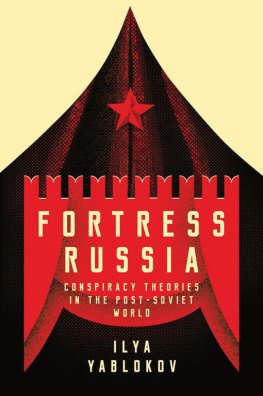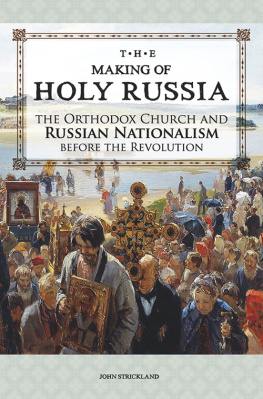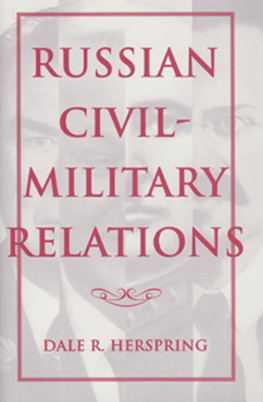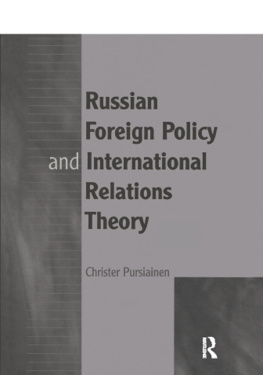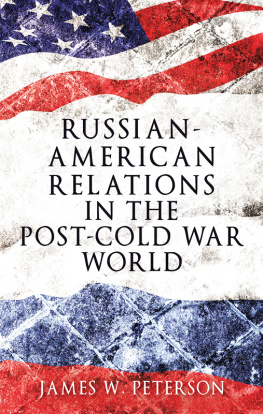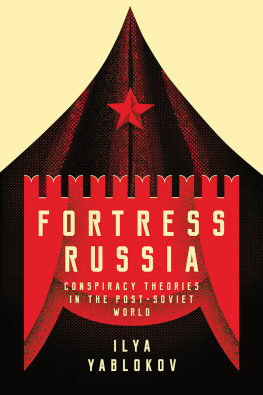IMAGINING RUSSIA
Making Feminist Sense of American Nationalism in U.S.Russian Relations
KIMBERLY A. WILLIAMS
Published by State University of New York Press, Albany
2012 State University of New York
All rights reserved
Printed in the United States of America
No part of this book may be used or reproduced in any manner whatsoever without written permission. No part of this book may be stored in a retrieval system or transmitted in any form or by any means including electronic, electrostatic, magnetic tape, mechanical, photocopying, recording, or otherwise without the prior permission in writing of the publisher.
For information, contact State University of New York Press, Albany, NY
www.sunypress.edu
Production by Kelli W. LeRoux
Marketing by Michael Campochiaro
Library of Congress Cataloging-in-Publication Data
Williams, Kimberly A. (Kimberly Ann), 1975
Imagining Russia : making feminist sense of American nationalism in U.S.-Russian relations / Kimberly A. Williams.
p. cm.
Includes bibliographical references and index.
ISBN 978-1-4384-3975-4 (hbk. : alk. paper)
1. Feminist theory. 2. NationalismUnited States 3. Mass media and nationalismUnited States. 4. Mass media and international relations 5. United StatesForeign relationsRussia (Federation) 6. United StatesForeign relationsSoviet Union. 7. National characteristics, Russian. 8. National characteristics in mass media. 9. Sex role. 10. Nationalism and feminism. I. Title.
HQ1190.W54 2012
303.48'24707309045dc22
2011009762
10 9 8 7 6 5 4 3 2 1
For Mom and Dad,
who have always encouraged and supported my curiosity.
Figures
| ; accessed October 12, 2010 |
Former President Ronald Reagan, winner of the cold war
Original photograph by Tony Korody |
Anya's ball gown
Kimberly A. Williams |
Acknowledgments
I am deeply grateful for the generous intellectual support given this project by the Women's Studies community at the University of Maryland, particularly those feminist scholars who introduced me to literatures, perspectives, and ways of understanding the world that I would not otherwise have encountered. Most important among them have been Michelle Rowley, Katie King, Seung-kyung Kim, Ruth Zambrana, Luh Ayu Saraswati, Na Young Lee, Clare Ching Jen, Kimberlee Staking, and Laura Logie. I also wish to thank Nancy Struna and Cynthia Martin, who each provided not only invaluable advice, but also extraordinary kindness at crucial stages in my research. And to Claire Moses, who nurtured this project from the beginning, I owe perhaps the most overdue acknowledgement for her continuing support and encouragement.
I am also hugely indebted to the members of a Washington, DC-based feminist chorus now called Fortissima. They welcomed me with open arms and, for three wonderful years, provided a space where I could sing and laugh and eat and become part of the DC feminist community and not worry about all the work I had left to do on this manuscript.
I owe many thanks, too, to the resourceful and efficient librarians at the University of Maryland and the Library of Congress, as well as to Katharine Barrette, the Policy Studies and Women's Studies librarian at Mount Royal University, whose assistance in the final stages of my research was invaluable. Thanks also go to SUNY Press, particularly the anonymous readers who awarded this project the 2009 SUNY Press Dissertation/First Book Prize in Women's and Gender Studies and, in the process, provided valuable suggestions for reworking parts of the manuscript.
My deepest gratitude goes to Kristen Williams, my sister, friend, and colleague, whose willingness to read, reread, and discuss my work over and over again has been crucial not only to this project, but to my development as a feminist scholar. Without her generosity of time, energy, and intellect, this project would still be a tangled mess on my hard drive.
have appeared in The Politics of Cultural Programming in Public Spaces, ed. Robert Gehl and Victoria Watts, pp. 96110 (London: Cambridge Scholars Publishing, 2010) and has been published here with the permission of Cambridge Scholars Publishing.
Introduction
Imagining Russia
As enemies are constructed, so are nations.
During the fall of 2005, the fashion design company Diesel featured a jeans advertisement that ran in the United States in GQ Magazine. In this ad, a shirtless young cowboy, culturally intelligible as white, lays prostrate, sprawled in apparent contented exhaustion across a plush red and black sofa ( achieves his orgasmand, most conveniently, they can be deflated, folded up, and packed away when not in use.
Figure 1. An advertisement for Diesel jeans. http://blog.zoozoom.com/advertisers/dollsemail.jpg; accessed October 12, 2010.
As an encounter between the United States and Russia, whose contentious relationship, known colloquially as the cold war, held geopolitics hostage in the latter half of the twentieth century, Additionally, the use of the matryoshka doll as a commodity to sell jeans, a classic American product, is, within the triumphalist narrative, both the ultimate proof and justification for the United States' cold war victory. Not only has capitalism trumped communism (as U.S. pundits and officials had promised all along), but the symbols and traditions of imperial Russia, itself, which in 1917 had been subsumed by the specter of communism, can now be freely integrated into the global capitalist marketplace.
This advertisement, then, in its efficient assemblage of the governing themes of American nationalism and U.S. foreign policy, is much more than an attempt to entice presumably elite white, young, heterosexual, male consumers to buy an expensive pair of jeans.
By the early 1990s, American-style capitalist democracy appeared to have triumphed over communist totalitarianism, and, in Russia, the state assets of a former superpower became the objects of neocolonial conquest for largely U.S. and Western corporate and political elites. The chapters that follow unpack not only what these gendered Russian imaginaries meant in their historical moment, but also how, why, when, by whom and for what purposes their meanings were constructed in order to interrogate the gendered, heteronormative, and racialized dynamics of U.S. Russia policy between the demise of the Soviet Union in 1991 and the U.S.-led invasion of Iraq in 2003.
In response to a call for a research methodology that attends to the linkages and travels of forms of representation as they intersect with movements of labor and capital in a multinational world, I draw explicitly on the methodologies and perspectives of American cultural studies, feminist international relations theories and policy analysis, women's and gender studies, feminist development studies, and theories of performance. Each of these locations of knowledge production has its own intellectual genealogy/ies, and, because my work here requires the flexibility of multiple and simultaneous perspectives, this project draws from and is in constant dialogue with each of them. My research has thus demanded that I be, concomitantly, an historian, a political scientist, a literary scholar, an economist, a scholar of nuclear proliferation, and a cultural criticjust to name a few of the hats I have worn while researching and writing this book. This project is in conversation with and contributes to efforts to situate within the transnational both American studies and women's gender, and sexuality studies.



